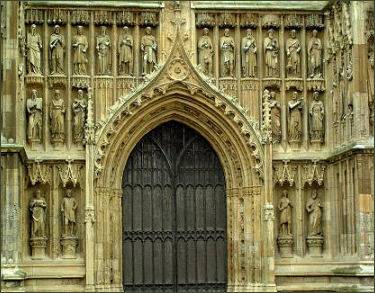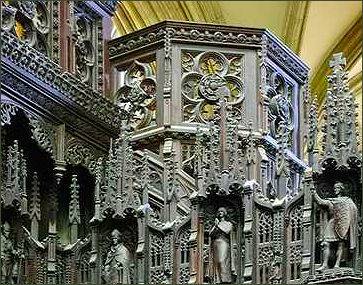Beverley Minster
OS grid reference:- TA 037 393

 Magnificent Beverley Minster, the parish church of the market town of Beverley in the East Riding of Yorkshire, is one of the largest and most beautiful parish churches in Britain, measuring 393 feet long, the church is larger than many cathedrals.
Magnificent Beverley Minster, the parish church of the market town of Beverley in the East Riding of Yorkshire, is one of the largest and most beautiful parish churches in Britain, measuring 393 feet long, the church is larger than many cathedrals.
Beverley Minster consists of long nave, twin transepts, choir, sanctuary and a retro quire. Although never given the status of a cathedral, the minster at Beverley, which was once the capital of the East Riding of Yorkshire, was a wealthy college church until the Dissolution of the Monasteries in the reign of King Henry VIII, when it was reduced to a parish church.
St. John of Beverley (died 7 May 721), was an English bishop active in the kingdom of Northumbria, who founded a monastery in about 700 AD in marshy woodland in East Yorkshire. Lots of beavers inhabited the woods at that time, hence, tradition relates, it became known as Beaver Ley.
John of Beverley was said to have been born of noble parents at the village of Harpham, in the East Riding of Yorkshire and was trained under St Hilda at Whitby. In 687 AD he became the Bishop of Hexham and later the Bishop of York. The saint's bones lie beneath a plaque in the nave of Beverley Minster. The Vikings almost destroyed the building but it was rebuilt in the tenth century when it was visited by the Anglo-Saxon king Athelstan prior to a battle with the Vikings. In 1138 the banner of St. John of Beverley was carried at the Battle of the Standard, in which English forces repelled a Scottish army near Northallerton.
John of Beverley was canonized in 1037 and when miracles were subsequently reported to have occured at his tomb, Beverley became a popular destination for pilgrims, his reputation changed the remote spot into a thriving medieval town. The foundation flourished after his death and was rebuilt several times. King Edward I was a devotee of John and furthered the cult. In 1295 Edward established a chantry in Beverley Minster in the saint's honour. In 1301, he gave 50 marks towards the building of the shrine and diverted half of a fine owed by the town to the same purpose and ceded the remaining half.
 In 1214 the tower of the Norman church collapsed and a new church was erected around St John's shrine, with work beginning around 1221.
It took two centuries to complete. The building is regarded as one of the finest examples of the Perpendicular style.
In 1214 the tower of the Norman church collapsed and a new church was erected around St John's shrine, with work beginning around 1221.
It took two centuries to complete. The building is regarded as one of the finest examples of the Perpendicular style.
Henry Percy, 4th Earl of Northumberland (1449-1489), is buried in the minster, he was killed by the citizens of York in 1489 during the Yorkshire Rebellion over high taxes imposed by King Henry VII.
In the eighteenth century the present central tower replaced an original lantern tower that was in danger of collapse. The central tower now houses the largest surviving treadwheel crane in England, which is used when raising building materials to a workshop located in the roof.
 In the style of its architecture, with its soaring Gothic arches, Beverley Minster resembles York Minster. A distinctive feature of both the north and south transepts is the presence of rose windows, and a White Rose of York. The great sixteenth century east window still retains much of its original medieval stained glass, while the marble font dates back to the Norman era.
In the style of its architecture, with its soaring Gothic arches, Beverley Minster resembles York Minster. A distinctive feature of both the north and south transepts is the presence of rose windows, and a White Rose of York. The great sixteenth century east window still retains much of its original medieval stained glass, while the marble font dates back to the Norman era.
Notable features include columns of Purbeck Marble, stiff-leaf carving and the tomb of Lady Eleanor Percy, wife of Henry Percy, first Lord Alnwick, which dates from around 1340 and is covered with a richly-decorated canopy. Also of note is the intricately carved organ screen which separates the nave from the choir. The screen was designed by the Victorian architect Sir George Gilbert Scott, and carved by James Elwell.
The fourteenth century reredos, situated behind the high altar, is covered with fine carving and sculptured figures of musicians. The minster also boasts 68 sixteenth century misericords, probably carved by the Ripon school of carvers, they are to be found in the quire of the minster and nearby is a sanctuary or frith stool or peace stool, dating back to the Anglo-Saxon era, one of but a few remaining in England. Anyone wanting to claim sanctuary from the law would sit in the chair.
